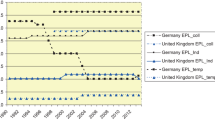Abstract
This study develops and empirically tests a theory which explains how workplace unionization affects worker responses to HRM innovation. We hypothesize that union support varies depending on whether the union perceives the innovation as a threat to its power base and institutional security or as an opportunity to increase its status and influence. This differential effect is expected to be curvilinear. Our hypothesis is generally supported by our sample of 230 organizations. Practical and research implications are discussed.
Similar content being viewed by others
References
Appelbaum, Eileen and Rosemary Batt. The New American Workplace. Ithaca, N.Y.: ILR Press, 1994.
—. “Worker Participation in Diverse Settings: Does the Form Affect the Outcome, and If So, Who Benefits?” British Journal of Industrial Relations 33 (September 1995): 353–78.
Belcher, J. G. Productivity Plus: How Today's Best Run Companies Are Gaining the Competitive Edge. Houston, Tex.: Gulf Publishing, 1987.
Bemmels, Brian. “How Unions Affect Productivity in Manufacturing Plants.” Industrial and Labor Relations Review 40 (January 1987): 241–53.
Berggren, Christian. Alternatives to Lean Production. Ithaca, N.Y.: ILR Press, 1992.
Betcherman, Gordon, Kathryn McMullen, Norm Leckie, and Christina Caron. The Canadian Workplace in Transition. Kingston, Ont.: IRC Press, 1994.
Bureau of Labour Information. Workplace Innovations Overview — 1994. Ottawa, Ont.: Human Resources Development Canada, 1994.
Cappelli, Peter, and Harbir Singh. “Integrating Strategic Human Resources and Strategic Management.” In David Lewin, Olivia S. Mitchell and Peter Sherer, eds. Research Frontiers in Industrial Relations and Human Resources. Madison, Wisc.: IRRA, 1992, pp. 165–92.
Cole, Robert E. ” A Japanese Import Comes Full Circle.” Wall Street Journal, February 22, 1983.
Cutcher-Gershenfeld, Joel, Patrick McHugh, and Donald Power. “Collective Bargaining in Small Firms: Preliminary Evidence of Fundamental Change.” Industrial and Labor Relations Review 49 (January 1996): 195–212.
Daft, Richard L., and Selwyn W. Becker. Innovation in Organizations. New York: Elsevier North Holland, 1978.
Deming, W. Edwards. Out of the Crisis. Cambridge, Mass.: MIT Press, 1986.
Grenier, G. J. Inhuman Relations: Quality Circles and Anti-Unionism in American Industry. Philadelphia: Temple University Press, 1988.
Kanter, Rosabeth M, “When a Thousand Flowers Bloom: Structural, Collective, and Social Conditions for Innovation in Organization.” In B. Staw and L. Cummings, eds. Research in Organizational Behavior 10 Greenwich, Conn.: JAI Press, 1988, pp. 169–211.
Kochan, Thomas A., Robert B. McKersie, and John Chalykoff. “The Effects of Corporate Strategy and Workplace Innovations on Union Representation.” Industrial and Labor Relations Review 39 (July 1986a): 487–501.
Kochan, Thomas A., Harry C. Katz, and Robert B. McKersie. The Transformation of American Industrial Relations. New York: Basic Books, 1986b.
MacDuffie, John Paul. “Human Resource Bundles and Manufacturing Performance: Organizational Logic and Flexible Production Systems in the World Auto Industry.” Industrial and Labor Relations Review 48 (January 1995): 197–221.
Mavrinac, Sarah C., Neil R. Jones, and Marshall W. Meyer. The Financial and Nonfinancial Returns to Innovative Workplace Practices. Ernst and Young Center for Business Innovation, 1995.
Metzgar, Jack. “Employee Involvement within an Adversarial Structure: A Bargaining Model of Worker Participation.” Proceedings of the Forty-Third Annual Meeting Washington, DC, December 28-30, 1989. Madison, Wisc.: IRRA, 1990, pp. 96–102.
Mitchell, Daniel J.B., David D. Lewin, and E.E. Lawler. “Alternative Pay Systems, Firm Performance, and Productivity.” In A.S. Blinder, ed. Paying for Productivity: A Look at the Evidence. Washington, D.C.: Brookings Institution, 1990, pp. 100–21.
Osterman, Paul. “How Common Is Workplace Transformation and Who Adopts It?” Industrial and Labor Relations Review 47 (January 1994): 173–88.
Parker, Mike, and Jane Slaughter. Choosing Sides: Unions and the Team Concept. Boston, Mass.: Labor Notes, 1988.
Rankin, Tom. New Forms of Work Organization: The Challenges for North American Unions. Toronto: University of Toronto Press, 1990.
Reshef, Yonatan, Brian Bemmels, and Richard A. Wolfe. “The Effect of Unionization on Workplace Innovation.” Economic and Industrial Democracy 14 (February 1993): 109–31.
Reshef, Yonatan, Helen Lam, and Mark Kizilos. Union Responses to Quality Initiatives. Working paper. Faculty of Business, University of Alberta, Edmonton, Canada, 1996.
Rousseau, D.M. “Issues of Level in Organizational Research: Multilevel and Cross-Level perspectives.” Research in Organizational Behavior 7 Greenwich, Conn.: JAI Press, 1985, pp. 1–37.
Turner, Lowell. Democracy at Work: Changing World Markets and the Future of Labor Unions. Ithaca, N.Y.: Cornell University Press, 1991.
UAW New Directions Movement Region 9A. Jointness at GM: Company Unionism for the 21st Century, 1994.
United Steelworkers. In Power in the Workplace. United Steelworkers' project, Technology adjustment research program (TRAP), 1994.
U.S. Department of Labor. High Performance Work Practices and Firm Competitiveness. Washington, D.C.: Office of the American Workplace, 1993.
Verma, Anil. “Joint Participation Programs: Self-help or Suicide for Labor?” Industrial Relations 28 (Fall 1989): 401–10.
—, and Robert B. McKersie. “Employee Involvement: The Implications of Noninvolvement by Unions.” Industrial and Labor Relations Review 40 (July 1987): 556–68.
Wells, Don. “Are Strong Unions Compatible with the New Model of Human Resource Management?” Relations Industrielles 48 (Winter 1993): 56–84.
Wever, Kirsten R. “Toward a Structural Account of Union Participation in Management: The Case of Western Airlines.” Industrial and Labor Relations Review 42 (July 1989): 600–09.
Wever, Kirsten S. Negotiating Competitiveness: Employment Relations and Organizational Innovation in Germany and the United States. Boston, Mass.: Harvard Business School Press, 1995.
Author information
Authors and Affiliations
Additional information
We are indebted to Kay Devine and Thomas G. Cummings for helpful comments on earlier versions of this paper.
Rights and permissions
About this article
Cite this article
Kizilos, M., Reshef, Y. The effects of workplace unionization on worker responses to HRM innovation. J Labor Res 18, 641–656 (1997). https://doi.org/10.1007/s12122-997-1028-1
Issue Date:
DOI: https://doi.org/10.1007/s12122-997-1028-1




